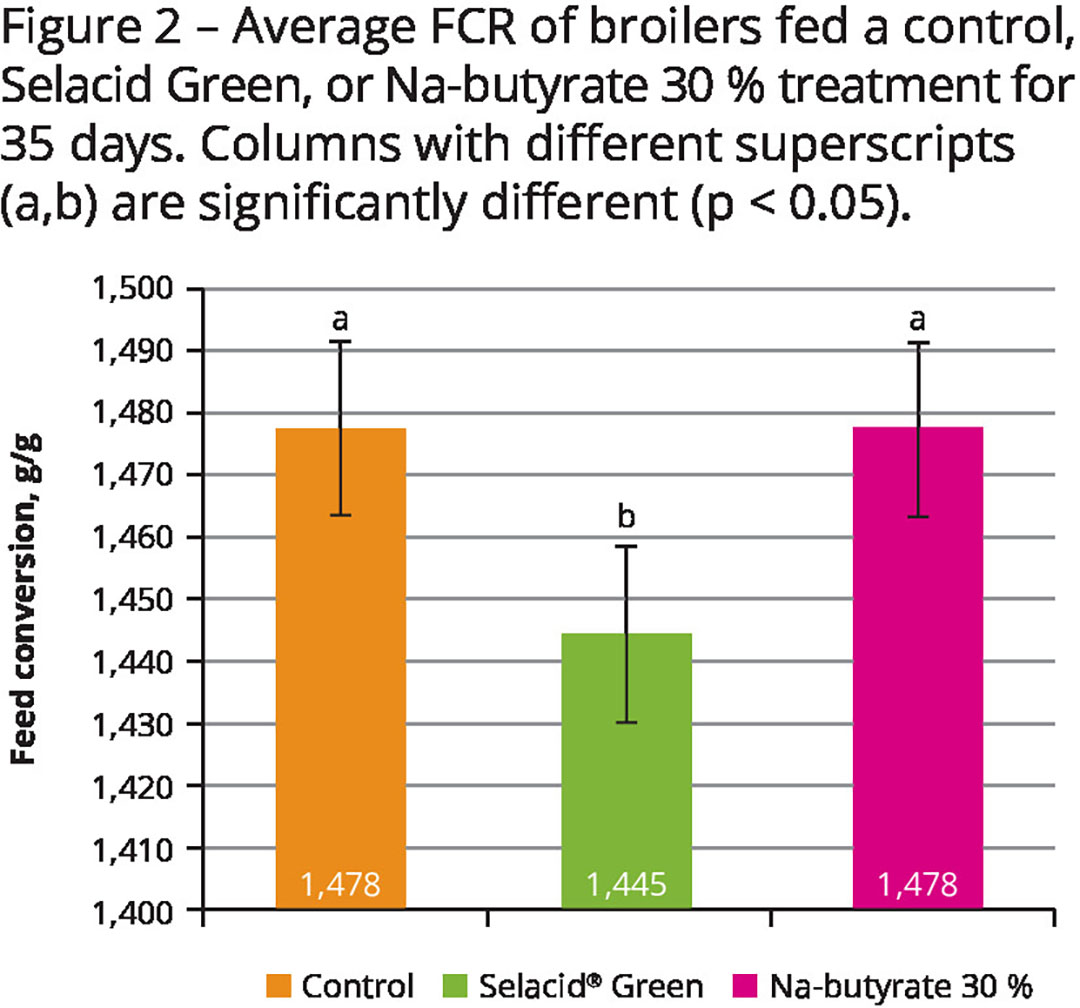Stocking density for broilers can vary greatly depending on bird size, nutrition, breed, feeder space, drinking space, house dimensions, bird welfare and economic return. Today, modern greenhouses allow higher densities as long as the environment is maintained properly. The use of organic acids can further alleviate inflammatory responses, restore gut health and growth performance.
High stocking density (HSD) is often used in broiler production in intensive or commercial poultry farming to maximize production efficiency and optimize the use of resources, such as space, feed and labour. While HSD can lead to increased production, it can also contribute to a number of important challenges, such as respiratory issues, increased stress and aggression, impaired gut health and foot disorders, all of which affect bird health and well-being.
Producers must find a balance between maximizing production and ensuring the health – and welfare – of the animals by using appropriate management practices, including adequate ventilation, disease control and proper nutrition, to overcome the challenges of HSD in managing broiler production. Supplementing the diet with feed additives may be one strategy to achieve the goal of maximizing chicken weight produced per square meter, and preventing production losses due to crowding.
Organic acids have been found to alleviate the negative effects of high stocking stress in broilers by restoring the intestinal microbiota, reducing inflammation, inhibiting the NF-kB signaling pathway and increasing the production of short-chain fatty acids. Researchers used a clever combination of short and medium fatty acids to develop Selko’s Selkoid Green Growth. Included in broiler feeding provides a tool to manage stress more effectively, maintain gut health and achieve growth performance.
HSD stress cost
Poultry raised in HSD production systems are exposed to increased stress which can negatively impact production efficiency and growth. Stressed birds can exhibit increased inflammation and impaired gut health, which can lead to leaky gut or damage to the tight junctions, allowing harmful bacteria to enter the bloodstream.
HSD can have a negative effect on the balance of gut microbiota and can lead to dysbiosis which can lead to increased use of antibiotics. Dysbiosis in broilers is estimated to inhibit feed conversion (FCR) by about 0.05, on average, without considering coccidiosis. Given the challenges presented by HSD systems, it is important to find alternative solutions to maintain the health and growth of birds in the face of production stress and without preventive dependence on antibiotics.
Putting acids to work
The top acts as the first place of fermentation within the gastrointestinal tract and food ingredients may influence its pH and play a role in providing desirable conditions for beneficial bacteria and undesirable conditions for pathogens. In addition, diets with a high buffering capacity can limit the acidity of the liver, allowing pathogenic bacteria to proliferate, as well as reduce the activity of digestive enzymes, allowing more undigested protein to reach the hindgut and cause inflammation and gut health problems.
This situation may also reduce the performance of the birds and lead to wet litter. As a preventive strategy, adding organic acids can maintain the level of acidity needed to support ‘good’ bacteria and resist colonization by pathogenic bacteria, as well as improve nutrient utilization in broilers.
What the science says
In a study that looked at the effect of high stocking density on poultry production with a basal diet and a diet supplemented with organic acids, 528 birds were divided into 3 production systems. One group was raised in a low stocking density environment (positive control), a second group in a high stocking density environment (negative control), and a third group in a high stocking density condition where the diet was supplemented with mixed organic acid feed. plugin. Birds were evaluated for growth performance, intestinal barrier and intestinal microbes, microbial metabolites and stress response indicators.
 Non-supplemented birds raised in HSD condition showed increased levels of several stress indicators, including higher levels of serum lipopolysaccharides corticosterone, interleukin-1 β, tumor necrosis factor-α, and down-regulated expression of ZO-1, which may hinder. growth performance. In comparison, bird diets supplemented with the organic acid blend (Growth Selacid Green). -1, and improved growth performance compared to the negative control group birds. In addition, supplemented birds showed an increase in size Bacteroidetes and restored the balance of the microbial ecosystem compared to the stressed, non-supplemented birds. Birds that received the organic acid blend showed higher levels of acetic and butyric acids that have a significant correlation with indicators of intestinal inflammation.
Non-supplemented birds raised in HSD condition showed increased levels of several stress indicators, including higher levels of serum lipopolysaccharides corticosterone, interleukin-1 β, tumor necrosis factor-α, and down-regulated expression of ZO-1, which may hinder. growth performance. In comparison, bird diets supplemented with the organic acid blend (Growth Selacid Green). -1, and improved growth performance compared to the negative control group birds. In addition, supplemented birds showed an increase in size Bacteroidetes and restored the balance of the microbial ecosystem compared to the stressed, non-supplemented birds. Birds that received the organic acid blend showed higher levels of acetic and butyric acids that have a significant correlation with indicators of intestinal inflammation.
Overall, the trial showed that Selacid Green Growth can play a role in mediating HSD-induced inflammatory responses and restoring gut microbial composition and growth performance, suggesting a positive impact of a nutritional strategy to alleviating HSD induced stress in broilers.
Blend for effect, efficiency and economy
In the second trial, the growth performance and feed conversion of 975 birds in antibiotic-free production was examined. Birds received one of 3 diets – control feed, feed with sodium butyrate additive, or feed containing an organic acid blend – for 35 days. Broilers fed the organic feed with acid showed an improved feed ratio, a better European Production Efficiency Factor (EPEF) and had a higher average body weight at the end of the trial. The EPEF or European broiler index is a production indicator calculated using average daily gain, percentage survival rate, feed conversion ratio, excluding mortality in the first week.
References available on request.